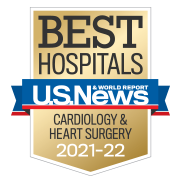An acute or chronic heart condition can become evident during a routine annual physical exam or through a specific set of symptoms, and expert diagnosis is crucial in determining the most appropriate course of treatment.
NewYork-Presbyterian doctors have access to the most advanced diagnostic equipment – often years before other hospitals – and can provide a full range of diagnostic services for heart disease. These are techniques currently in use at NYP to diagnose heart disease:
Techniques
Angiography
Angiography is where a tube or catheter is inserted into a blood vessel (usually in the groin) and is guided toward the heart with the assistance of x-ray imaging. Dye is then introduced into the arteries to visualize them clearly, and digital cine films (angiograms) are recorded and analyzed.
Cardiac MRI
Cardiac Magnetic Resonance Imaging (MRI) uses a combination of a large magnet, radiofrequencies, and a computer to process detailed cardiovascular images. This non-invasive, safe method scans the body to produce information on the heart's anatomy and its blood vessels.
Chest X-Ray
Doctors take an x-ray of the chest to look for abnormalities.
Echocardiography
Echocardiography is a safe, non-invasive diagnostic test that uses high-frequency sound waves (not detectable by the human ear) to produce images of the heart and its vessels.
Electrocardiography
Electrocardiography (ECG or EKG) is a diagnostic test to detect abnormalities in the heart's rhythm. It also can provide important information about damage to the heart, valve disorders, and structural abnormalities in the heart's walls.
Holter Monitoring
With Holter Monitoring the patient wears a portable ECG heart monitor to track heart activity during daily activities at home and at work.
Myocardial Biopsy
With Myocardial Biopsy a sampling of heart muscle is removed from the heart and analyzed.
Nuclear Imaging
Nuclear imaging evaluates how organs function. Small amounts of a radioactive solution that is safe and has no side effects are introduced into the body. A special camera detects the solution in different parts of the body and a computer generates a series of images of the areas of interest.
Stress Testing
In Stress Testing, heart function is assessed while the patient exercises (such as on a treadmill).
TEE
Transesophageal Echocardiography (TEE) is a diagnostic test used to measure the sound waves that bounce off the heart, creating a graphic image of the movement of the heart structures. Unlike standard echocardiography, during TEE, a slender transducer is inserted into the esophagus via the patient's throat, providing a clearer image of the heart.
Tilt Table Testing
Tilt Table Testing is used to evaluate the cause of syncope (fainting), which can occur in some patients with arrhythmias. During this non-invasive test, the patient lies flat, is secured on a table, and is tilted upright to a near-standing position, with continuous ECG and blood pressure monitoring. In some patients, this simple maneuver will confirm the triggering of certain cardiovascular reflexes and diagnose the cause of syncope.




